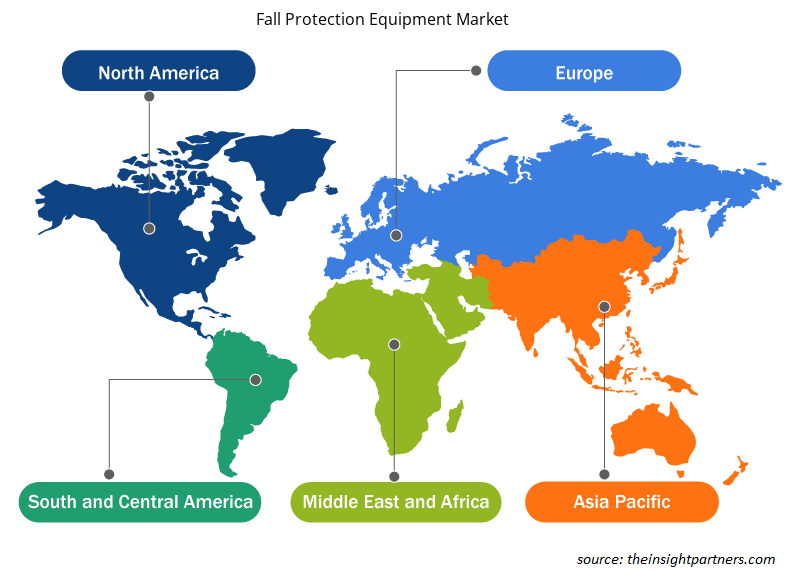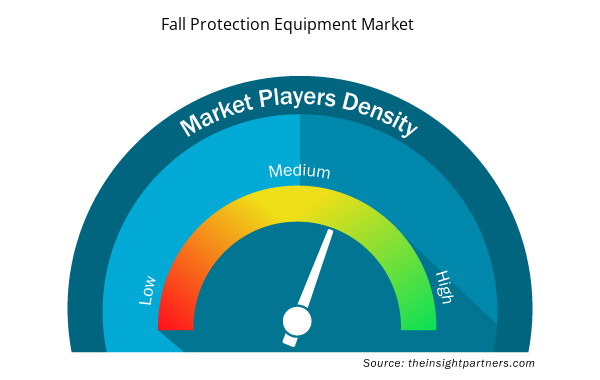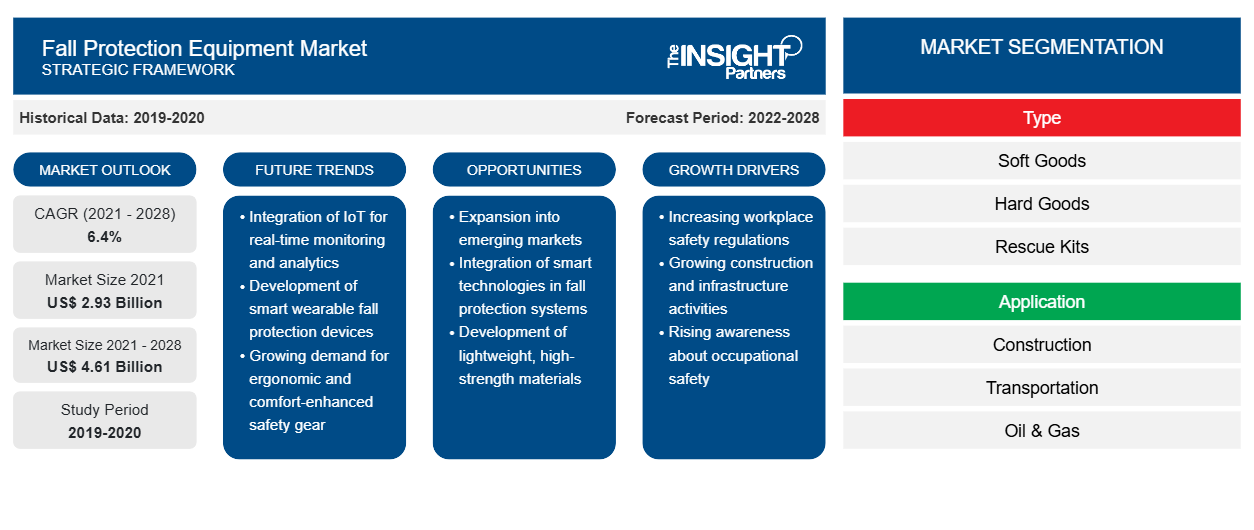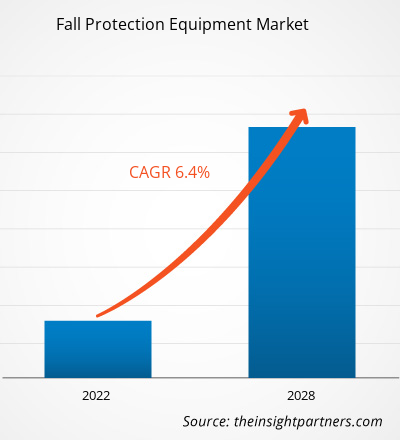Si prevede che il mercato dei dispositivi di protezione anticaduta crescerà da 2.934,86 milioni di dollari nel 2021 a 4.606,61 milioni di dollari entro il 2028; si stima che crescerà a un CAGR del 6,4% nel periodo 2021-2028.
La rapida industrializzazione nei paesi sviluppati e in via di sviluppo è uno dei principali fattori che guidano l'espansione del mercato. I rischi professionali stanno diventando sempre più diffusi a causa della mancanza di adeguate procedure di sicurezza in vari siti di produzione, estrazione mineraria e altri siti industriali. Rispetto ad altri paesi, gli Stati Uniti sono più preoccupati per la sicurezza e la salute dei propri lavoratori, il che sta guidando l'adozione di dispositivi di protezione anticaduta nel paese. Per supervisionare le norme e le procedure di sicurezza, il paese ha istituito alcune autorità come l'Occupational Safety and Health Administration (OSHA) e l'American National Standards Institute (ANSI). L'OSHA è un'organizzazione per la conformità e le normative sulla salute e sicurezza che fornisce ai lavoratori una formazione di sensibilizzazione di 10 ore e 30 ore sulle normative e gli standard OSHA pertinenti a varie professioni sul posto di lavoro. Tuttavia, la crescente attenzione alle pratiche di sicurezza sul lavoro e il miglioramento delle normative governative per la sicurezza dei lavoratori in Europa e Asia hanno guidato il mercato. Le crescenti attività di costruzione e il crescente settore petrolifero e del gas nei paesi asiatici come India e Cina, a causa della popolazione in aumento, dovrebbero rafforzare la crescita del mercato durante il periodo di previsione. L'aumento dell'urbanizzazione e la crescita del settore petrolifero e del gas sono tra i fattori chiave che sostengono la crescita del mercato dei dispositivi di protezione anticaduta nelle regioni MEA (Medio Oriente e Africa) e SAM (Sud America).
Personalizza questo report in base alle tue esigenze
Riceverai la personalizzazione gratuita di qualsiasi report, comprese parti di questo report, o analisi a livello nazionale, pacchetto dati Excel, oltre a usufruire di grandi offerte e sconti per start-up e università
- Scopri le principali tendenze di mercato in questo rapporto.Questo campione GRATUITO includerà analisi di dati che spaziano dalle tendenze di mercato alle stime e alle previsioni.
Impatto della pandemia di COVID-19 sul mercato delle attrezzature di protezione anticaduta
Anche nel 2021, l'epidemia di COVID-19 ha continuato a produrre effetti negativi in diversi paesi. Le chiusure degli impianti di produzione o le operazioni commerciali limitate e i lockdown e le limitazioni di viaggio hanno ostacolato la produzione e la catena di fornitura di dispositivi di protezione anticaduta. La domanda costante di dispositivi di protezione anticaduta ha registrato un leggero calo nel 2020, a causa del lockdown imposto dal governo e di un basso numero di progetti di costruzione. Tuttavia, nel 2021, a causa di un aumento delle attività di costruzione, dell'esplorazione di petrolio e gas e dei progetti di telecomunicazioni, c'è una domanda di dispositivi di protezione anticaduta per garantire la sicurezza dei dipendenti. Anche le attività di e-commerce hanno contribuito ad aumentare la necessità di dispositivi di protezione anticaduta nel settore delle costruzioni.
Approfondimenti sul mercato delle attrezzature di protezione anticaduta
Aumento delle attività di costruzione
L'aumento delle attività di costruzione in tutto il mondo è un elemento primario che guida il mercato delle attrezzature di protezione anticaduta. Poiché i paesi asiatici come India e Cina stanno assistendo a una significativa crescita demografica, la domanda di spazi commerciali e residenziali in questi paesi è in continua espansione. L'economia globale sta attualmente vivendo un forte rallentamento a causa di un vincolo di credito in via di sviluppo che sta facendo sì che le economie di tutto il mondo perdano le loro ambizioni di sviluppo. Le infrastrutture rimangono una priorità importante per affrontare le lacune di sviluppo nello scenario attuale, poiché sono viste come onnipotenti e in grado di far uscire le economie dai tumulti finanziari. I governi di tutto il mondo stanno pompando denaro in infrastrutture fisiche e sociali per aumentare la domanda di prodotti e servizi creando posti di lavoro.
Approfondimenti di mercato basati sul tipo
In base al tipo, il mercato delle attrezzature anticaduta è suddiviso in beni morbidi, beni durevoli, kit di soccorso, cinture per il corpo, imbracature per il corpo completo e altri. Il segmento dei beni durevoli è il segmento leader in quanto offre una maggiore sicurezza. Inoltre, la crescente innovazione in questo segmento dovrebbe stimolare la crescita del mercato. Tuttavia, la crescente domanda di sistemi di imbracature per il corpo completo da parte di tutti gli utenti industriali sta aiutando il segmento a crescere al CAGR più elevato.
Approfondimenti di mercato basati sulle applicazioni
In termini di applicazione, il mercato delle attrezzature di protezione anticaduta è suddiviso in edilizia, petrolio e gas, trasporti, energia e servizi di pubblica utilità e telecomunicazioni. Per garantire un flusso efficace delle attività e mantenere la sicurezza dei lavoratori, ogni settore richiede attrezzature di protezione anticaduta nelle proprie strutture. Nel 2020, il segmento dell'edilizia ha rappresentato la quota di mercato maggiore.
Gli operatori che operano nel mercato delle attrezzature di protezione anticaduta adottano strategie quali fusioni, acquisizioni e iniziative di mercato per mantenere le proprie posizioni nel mercato. Di seguito sono elencati alcuni sviluppi da parte degli operatori chiave:
- Nel maggio 2021, Pure Safety Group ha riunito la sua famiglia di marchi di sicurezza in altezza, Stronghold by PSG, Ty-Flt, Checkmate e HART, sotto il marchio Guardian. Questa espansione ha reso Guardian il più grande marchio indipendente al mondo di protezione e prevenzione delle cadute.
- Entro la fine di marzo 2021, 3M Fall Protection ha inventato e incluso le cinghie di sicurezza antitrauma in sospensione su tutte le imbracature 3M DBI SALA certificate ANSI e CSA.
Approfondimenti regionali sul mercato delle attrezzature di protezione anticaduta
Le tendenze regionali e i fattori che influenzano il mercato delle attrezzature di protezione dalle cadute durante il periodo di previsione sono stati ampiamente spiegati dagli analisti di Insight Partners. Questa sezione discute anche i segmenti e la geografia del mercato delle attrezzature di protezione dalle cadute in Nord America, Europa, Asia Pacifico, Medio Oriente e Africa e America centrale e meridionale.

- Ottieni i dati specifici regionali per il mercato delle attrezzature di protezione anticaduta
Ambito del rapporto di mercato sulle attrezzature di protezione anticaduta
| Attributo del report | Dettagli |
|---|---|
| Dimensioni del mercato nel 2021 | 2,93 miliardi di dollari USA |
| Dimensioni del mercato entro il 2028 | 4,61 miliardi di dollari USA |
| CAGR globale (2021 - 2028) | 6,4% |
| Dati storici | 2019-2020 |
| Periodo di previsione | 2022-2028 |
| Segmenti coperti | Per tipo
|
| Regioni e Paesi coperti | America del Nord
|
| Leader di mercato e profili aziendali chiave |
|
Densità degli attori del mercato: comprendere il suo impatto sulle dinamiche aziendali
Il mercato delle attrezzature di protezione dalle cadute sta crescendo rapidamente, spinto dalla crescente domanda degli utenti finali dovuta a fattori quali l'evoluzione delle preferenze dei consumatori, i progressi tecnologici e una maggiore consapevolezza dei vantaggi del prodotto. Con l'aumento della domanda, le aziende stanno ampliando le loro offerte, innovando per soddisfare le esigenze dei consumatori e capitalizzando sulle tendenze emergenti, il che alimenta ulteriormente la crescita del mercato.
La densità degli operatori di mercato si riferisce alla distribuzione di aziende o società che operano in un particolare mercato o settore. Indica quanti concorrenti (operatori di mercato) sono presenti in un dato spazio di mercato in relazione alle sue dimensioni o al valore di mercato totale.
Le principali aziende che operano nel mercato delle attrezzature di protezione anticaduta sono:
- 3 milioni
- Tecnologia fallita
- Produzione di French Creek
- In prima linea
- Protezione anticaduta Guardian
Disclaimer : le aziende elencate sopra non sono classificate secondo un ordine particolare.

- Ottieni una panoramica dei principali attori del mercato delle attrezzature di protezione anticaduta
Il mercato globale delle attrezzature di protezione anticaduta è stato segmentato come indicato di seguito:
Per tipo
- Beni morbidi
- Beni durevoli
- Kit di salvataggio
- Cinture per il corpo
- Imbracatura completa per il corpo
- Altri
Per applicazione
- Costruzione
- Trasporti
- Petrolio e gas
- Estrazione mineraria
- Energia e servizi di pubblica utilità
- Telecom
- Altri
Per Geografia
America del Nord
- NOI
- Canada
- Messico
Europa
- Francia
- Germania
- Italia
- Regno Unito
- Russia
- Resto d'Europa
Asia Pacifico (APAC)
- Cina
- India
- Corea del Sud
- Giappone
- Australia
- Resto dell'APAC
Medio Oriente e Africa (MEA)
- Sudafrica
- Arabia Saudita
- Emirati Arabi Uniti
- Resto del MEA
America del Sud (SAM)
- Brasile
- Argentina
- Resto del SAM
Profili aziendali
- 3 milioni
- Tecnologia fallita
- Produzione di French Creek
- In prima linea
- Protezione anticaduta Guardian
- Sicurezza Kee
- Sicurezza Kwik
- Sicurezza MSA Incorporata
- Honeywell International Inc.
- Protezione anticaduta Tritech
- Analisi storica (2 anni), anno base, previsione (7 anni) con CAGR
- Analisi PEST e SWOT
- Valore/volume delle dimensioni del mercato - Globale, regionale, nazionale
- Industria e panorama competitivo
- Set di dati Excel



Report Coverage
Revenue forecast, Company Analysis, Industry landscape, Growth factors, and Trends

Segment Covered
This text is related
to segments covered.

Regional Scope
North America, Europe, Asia Pacific, Middle East & Africa, South & Central America

Country Scope
This text is related
to country scope.
Domande frequenti
3M; Falltech; French Creek Production; Frontline; Gravitec Systems, Inc.; Guardian Fall (Pure Safety Group, Inc.); Honeywell International Inc; Kwiksafety; Kee Safety, Inc; and Msa are the key companies in the fall protection equipment market.
APAC led the global fall protection equipment market with the highest growth rate in 2020, followed by North America and Europe. In the coming years, the market in Asia would witness a massive growth in demand for fall protection equipment, owing to the rise in population of countries in the region, coupled with various government initiatives to attract private investments in construction and infrastructure development. Moreover, the surging number of commercial and industrial end users is inclined to use fall protection equipment to keep their workers safe from hazards.
The construction segment led the fall protection equipment market globally with a highest market share in the year 2020 and is expected to continue its dominance during the forecast period till 2028. The construction sector is the most common end user of fall prevention systems, as it has the highest annual injury rate. The global construction sector is responsible for more than a third of all workplace deaths each year. Due to a large number of planned building projects, the US is one of the most important countries for safety equipment on construction sites. As mandated by administrations in several states across the US, the use of fall protection systems to reduce the number of accidents and fatalities during building activities is expected to fuel the growth of this market. The US country is one of the major construction industry markets, with a spending worth of ~1.5 trillion in June 2021. Recent advancements in construction technologies and rising demand for worker safety solutions have driven the market growth. However, the shutdown of construction projects and delayed residential projects investments due to the COVID - 19 pandemic has severely impacted the market growth as the demand for fall protection equipment has been lowered.
The fall protection equipment market by product type was led by hard goods which held a market share of 36.8% in the year 2020 and is anticipated to continue its dominance during the forecast period to account for 37.8% share of the fall protection equipment market by the year 2028. The development of hard good (those made from metal or other non-synthetic materials) fall equipment is focused on adaptability and efficiency. Anchors, carabiners, rope grabs, and retractable blocks are examples of hard goods. Anchors are extremely capable of supporting intended weights and assisting in the prevention of falls. The use of hard goods is important in the mining sector since it increases worker flexibility and convenience. The growth of the mining sector in the US is expected to boost the demand for these products. Rope grabs are the ideal alternative for vertical and horizontal lifeline systems used in construction and mining industries because they enable level and inertial locking to prevent the fall. Today's hard goods have various capacities, and they reduce the amount of equipment required at the workplace. Self-retracting lifelines with a built-in rescue system are a newer addition. Depending on the surroundings, these devices, which may be programmed to automatically lower a worker in the event of a fall, can obviate the need for a separate rescue system on site.
With the rising speed and progress of structure and building design, the problems and hazards associated with it are also increasing. To maintain safety requirements, the safety equipment must also be upgraded over time. As a result of changing patterns, governments across the world have revised their fall protection requirements. Current fall prevention equipment has undergone adjustments as a result of the revised standard. The standard mandates that gate strength requirements for snap hooks and carabiners be doubled to 3,600 pounds in all directions of possible loading. The old ANSI standard demanded 220 pounds on the gate's face and 350 pounds on the gate's side, even though many manufacturers were already fulfilling the new standard's criteria when it was approved. To optimize fall arrest, harnesses must now include D-rings in the front and rear, and twin-leg lanyards must be tested before use and have cautions on product labels on how to use them appropriately. As a result, fall protection equipment suppliers will see creating adjustable fall protection equipment as a prime opportunity.
The rise in construction activities around the world is a primary element driving the fall protection equipment market. As Asian countries such as India and China are witnessing significant population growth, the demand for commercial and residential spaces in these countries is constantly expanding. The global economy is currently experiencing a severe slowdown due to a developing credit constraint that is causing economies around the world to miss their developmental ambitions. Infrastructure remains a major priority for addressing developmental gaps in the current scenario, as it is seen as omnipotent and capable of bringing economies out of financial upheaval. Governments all over the world are pumping money into physical and social infrastructure to increase the demand for products and services by creating jobs. During COVID, Construction is more important than ever in this difficult time. The sector has played a crucial role in responding to the crisis and in the recovery, from erecting hospitals in a matter of days to giving lifesaving equipment. The construction industry accounts for 13% of global GDP, and the increasing worker availability could assist recovery while tackling the most pressing issues. Despite challenges in 2020, the oil industry is finally starting to recover. As a consequence, the economy is boosting. The aforementioned factors are expected to fuel the need for fall protection equipment worldwide.
Trends and growth analysis reports related to Manufacturing and Construction : READ MORE..
The List of companies - Fall Protection Equipment Market
- 3M
- Falltech
- French Creek Production
- Frontline
- Guardian Fall Protection
- Kee Safety
- KwikSafety
- MSA Safety Incorporated
- Honeywell International Inc.
- Tritech Fall Protection
The Insight Partners performs research in 4 major stages: Data Collection & Secondary Research, Primary Research, Data Analysis and Data Triangulation & Final Review.
- Data Collection and Secondary Research:
As a market research and consulting firm operating from a decade, we have published and advised several client across the globe. First step for any study will start with an assessment of currently available data and insights from existing reports. Further, historical and current market information is collected from Investor Presentations, Annual Reports, SEC Filings, etc., and other information related to company’s performance and market positioning are gathered from Paid Databases (Factiva, Hoovers, and Reuters) and various other publications available in public domain.
Several associations trade associates, technical forums, institutes, societies and organization are accessed to gain technical as well as market related insights through their publications such as research papers, blogs and press releases related to the studies are referred to get cues about the market. Further, white papers, journals, magazines, and other news articles published in last 3 years are scrutinized and analyzed to understand the current market trends.
- Primary Research:
The primarily interview analysis comprise of data obtained from industry participants interview and answers to survey questions gathered by in-house primary team.
For primary research, interviews are conducted with industry experts/CEOs/Marketing Managers/VPs/Subject Matter Experts from both demand and supply side to get a 360-degree view of the market. The primary team conducts several interviews based on the complexity of the markets to understand the various market trends and dynamics which makes research more credible and precise.
A typical research interview fulfils the following functions:
- Provides first-hand information on the market size, market trends, growth trends, competitive landscape, and outlook
- Validates and strengthens in-house secondary research findings
- Develops the analysis team’s expertise and market understanding
Primary research involves email interactions and telephone interviews for each market, category, segment, and sub-segment across geographies. The participants who typically take part in such a process include, but are not limited to:
- Industry participants: VPs, business development managers, market intelligence managers and national sales managers
- Outside experts: Valuation experts, research analysts and key opinion leaders specializing in the electronics and semiconductor industry.
Below is the breakup of our primary respondents by company, designation, and region:

Once we receive the confirmation from primary research sources or primary respondents, we finalize the base year market estimation and forecast the data as per the macroeconomic and microeconomic factors assessed during data collection.
- Data Analysis:
Once data is validated through both secondary as well as primary respondents, we finalize the market estimations by hypothesis formulation and factor analysis at regional and country level.
- Macro-Economic Factor Analysis:
We analyse macroeconomic indicators such the gross domestic product (GDP), increase in the demand for goods and services across industries, technological advancement, regional economic growth, governmental policies, the influence of COVID-19, PEST analysis, and other aspects. This analysis aids in setting benchmarks for various nations/regions and approximating market splits. Additionally, the general trend of the aforementioned components aid in determining the market's development possibilities.
- Country Level Data:
Various factors that are especially aligned to the country are taken into account to determine the market size for a certain area and country, including the presence of vendors, such as headquarters and offices, the country's GDP, demand patterns, and industry growth. To comprehend the market dynamics for the nation, a number of growth variables, inhibitors, application areas, and current market trends are researched. The aforementioned elements aid in determining the country's overall market's growth potential.
- Company Profile:
The “Table of Contents” is formulated by listing and analyzing more than 25 - 30 companies operating in the market ecosystem across geographies. However, we profile only 10 companies as a standard practice in our syndicate reports. These 10 companies comprise leading, emerging, and regional players. Nonetheless, our analysis is not restricted to the 10 listed companies, we also analyze other companies present in the market to develop a holistic view and understand the prevailing trends. The “Company Profiles” section in the report covers key facts, business description, products & services, financial information, SWOT analysis, and key developments. The financial information presented is extracted from the annual reports and official documents of the publicly listed companies. Upon collecting the information for the sections of respective companies, we verify them via various primary sources and then compile the data in respective company profiles. The company level information helps us in deriving the base number as well as in forecasting the market size.
- Developing Base Number:
Aggregation of sales statistics (2020-2022) and macro-economic factor, and other secondary and primary research insights are utilized to arrive at base number and related market shares for 2022. The data gaps are identified in this step and relevant market data is analyzed, collected from paid primary interviews or databases. On finalizing the base year market size, forecasts are developed on the basis of macro-economic, industry and market growth factors and company level analysis.
- Data Triangulation and Final Review:
The market findings and base year market size calculations are validated from supply as well as demand side. Demand side validations are based on macro-economic factor analysis and benchmarks for respective regions and countries. In case of supply side validations, revenues of major companies are estimated (in case not available) based on industry benchmark, approximate number of employees, product portfolio, and primary interviews revenues are gathered. Further revenue from target product/service segment is assessed to avoid overshooting of market statistics. In case of heavy deviations between supply and demand side values, all thes steps are repeated to achieve synchronization.
We follow an iterative model, wherein we share our research findings with Subject Matter Experts (SME’s) and Key Opinion Leaders (KOLs) until consensus view of the market is not formulated – this model negates any drastic deviation in the opinions of experts. Only validated and universally acceptable research findings are quoted in our reports.
We have important check points that we use to validate our research findings – which we call – data triangulation, where we validate the information, we generate from secondary sources with primary interviews and then we re-validate with our internal data bases and Subject matter experts. This comprehensive model enables us to deliver high quality, reliable data in shortest possible time.


 Ottieni un campione gratuito per questo repot
Ottieni un campione gratuito per questo repot